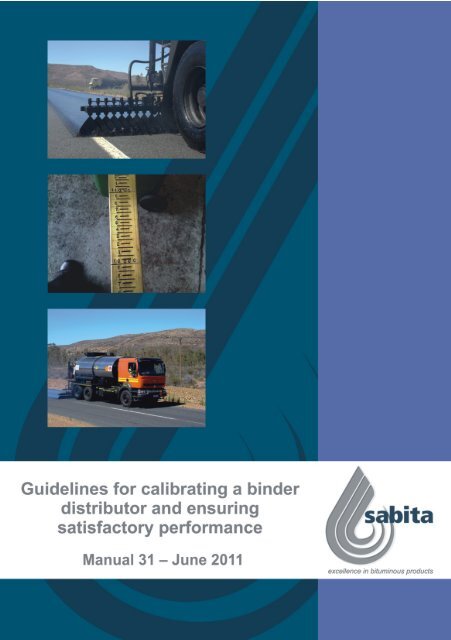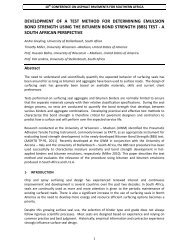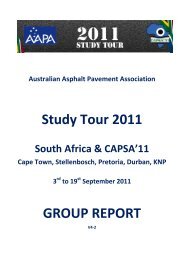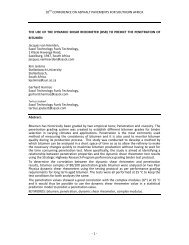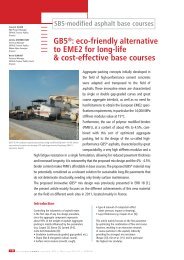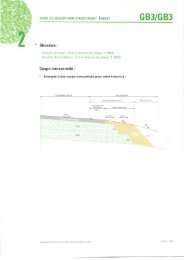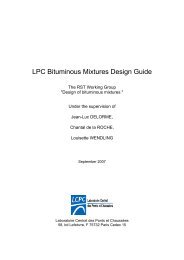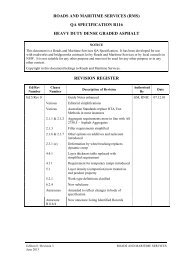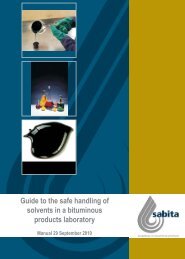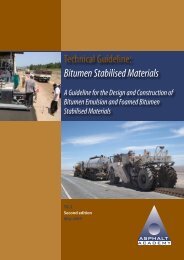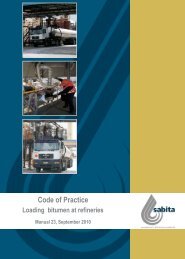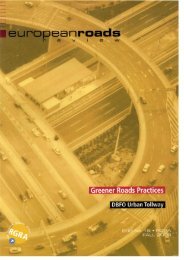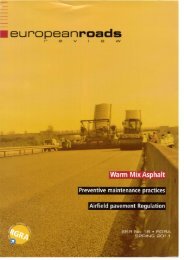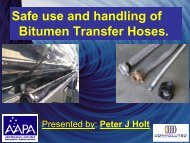Manual 31 Guidelines for calibrating a binder distributor ... - Aapaq.org
Manual 31 Guidelines for calibrating a binder distributor ... - Aapaq.org
Manual 31 Guidelines for calibrating a binder distributor ... - Aapaq.org
You also want an ePaper? Increase the reach of your titles
YUMPU automatically turns print PDFs into web optimized ePapers that Google loves.
<strong>Manual</strong> <strong>31</strong><br />
<strong>Guidelines</strong> <strong>for</strong> <strong>calibrating</strong> a <strong>binder</strong><br />
<strong>distributor</strong> and ensuring satisfactory<br />
per<strong>for</strong>mance<br />
Published by Sabita<br />
Postnet Suite 56<br />
Private Bag X21<br />
Howard Place 7450<br />
SOUTH AFRICA<br />
ISBN 978-1-874968-53-5<br />
Published June 2011<br />
Disclaimer<br />
Considerable ef<strong>for</strong>t has been made to ensure the accuracy and reliability of<br />
the in<strong>for</strong>mation contained in this publication. However, neither Sabita nor any<br />
of its members can accept any liability whatsoever <strong>for</strong> any loss, damage or<br />
injury resulting from the use of this in<strong>for</strong>mation. The contents of this<br />
publication do not necessarily represent the views of all members of Sabita.<br />
This document is provided to the reader as a service by Sabita and is<br />
intended <strong>for</strong> the sole use of the reader. It remains the property of Sabita. It<br />
may not be given to any third party, or copied and given to a third party, in<br />
part or in whole, without the express written permission of Sabita.<br />
ii
<strong>Manual</strong>s published by Sabita<br />
<strong>Manual</strong> 1<br />
<strong>Manual</strong> 2<br />
<strong>Manual</strong> 3*<br />
<strong>Manual</strong> 4*<br />
<strong>Manual</strong> 5<br />
<strong>Manual</strong> 6*<br />
<strong>Manual</strong> 7<br />
<strong>Manual</strong> 8<br />
<strong>Manual</strong> 9<br />
<strong>Manual</strong> 10<br />
<strong>Manual</strong> 11<br />
<strong>Manual</strong> 12<br />
<strong>Manual</strong> 13<br />
<strong>Manual</strong> 14***<br />
<strong>Manual</strong> 15*<br />
<strong>Manual</strong> 16**<br />
<strong>Manual</strong> 17<br />
<strong>Manual</strong> 18<br />
<strong>Manual</strong> 19<br />
<strong>Manual</strong> 20<br />
<strong>Manual</strong> 21***<br />
<strong>Manual</strong> 22<br />
<strong>Manual</strong> 23<br />
<strong>Manual</strong> 24<br />
<strong>Manual</strong> 25<br />
<strong>Manual</strong> 26<br />
<strong>Manual</strong> 27<br />
<strong>Manual</strong> 28<br />
<strong>Manual</strong> 29<br />
<strong>Manual</strong> 30<br />
<strong>Manual</strong> <strong>31</strong><br />
Construction of bitumen rubber seals<br />
Bituminous <strong>binder</strong>s <strong>for</strong> road construction and maintenance<br />
Test methods <strong>for</strong> bitumen rubber<br />
Specifications <strong>for</strong> rubber in <strong>binder</strong>s<br />
Manufacture and construction of hot mix asphalt<br />
Interim specifications <strong>for</strong> bitumen rubber<br />
SuperSurf: Economic warrants <strong>for</strong> surfacing unpaved roads<br />
Safe and responsible handling of bituminous products (CD only)<br />
Bituminous surfacings <strong>for</strong> temporary deviations<br />
Appropriate standards <strong>for</strong> bituminous surfacings<br />
Labour enhanced construction <strong>for</strong> bituminous surfacings<br />
Methods <strong>for</strong> labour intensive construction of bituminous surfacings (CD only)<br />
LAMBS – The design and use of large aggregate mixes <strong>for</strong> bases<br />
GEMS – The design and use of granular emulsion mixes<br />
Technical guidelines <strong>for</strong> seals using homogeneous modified <strong>binder</strong>s<br />
REACT – Economic analysis of short-term rehabilitation actions<br />
The design and use of porous asphalt mixes (CD only)<br />
Appropriate standards <strong>for</strong> the use of sand asphalt<br />
<strong>Guidelines</strong> <strong>for</strong> the design, manufacture and construction of bitumen rubber asphalt wearing courses<br />
Sealing of active cracks in road pavements<br />
ETBs – The design and use of emulsion treated bases<br />
Hot mix paving in adverse weather<br />
Code of Practice: Loading bitumen at refineries (CD only)<br />
User guide <strong>for</strong> the design of hot mix asphalt<br />
Quality management in the handling and transport of bituminous <strong>binder</strong>s<br />
Interim guidelines <strong>for</strong> primes and stone precoating fluids<br />
Guideline <strong>for</strong> thin layer hot mix asphalt wearing courses on residential streets<br />
Best practice <strong>for</strong> the design and construction of slurry seals (CD only)<br />
Guide to the safe use of solvents in a bituminous products laboratory (CD only)<br />
A guide to the selection of bituminous <strong>binder</strong>s <strong>for</strong> road construction (CD only)<br />
<strong>Guidelines</strong> <strong>for</strong> <strong>calibrating</strong> a <strong>binder</strong> <strong>distributor</strong> and ensuring satisfactory per<strong>for</strong>mance<br />
* Withdrawn and their contents have been incorporated in Technical Guideline 1 (see below)<br />
** Withdrawn and its software incorporated in TRH12: Flexible pavement rehabilitation investigation and design<br />
***These manuals have been withdrawn and contents incorporated in Technical Guideline 2 (see below).<br />
Technical <strong>Guidelines</strong><br />
TG1<br />
TG2<br />
TG3<br />
The use of modified <strong>binder</strong>s in road construction<br />
Bitumen stabilised materials<br />
Asphalt rein<strong>for</strong>cement <strong>for</strong> road construction<br />
DVDs<br />
DVD100<br />
DVD200<br />
DVD300<br />
DVD410<br />
DVD420<br />
DVD430<br />
DVD440<br />
Testing of bituminous products<br />
Repair of blacktop roads<br />
Hot mix asphalt<br />
The safe handling of bitumen<br />
Treatment of bitumen burns<br />
Working safely with bitumen<br />
Firefighting in the bituminous product industry<br />
iii
CONTENTS<br />
ACKNOWLEDGEMENTS . . . . . . . . . . . . . . . . . . . . . . . . .<br />
vi<br />
INTRODUCTION . . . . . . . . . . . . . . . . . . . . . . . . . . . . . . 7<br />
PART A: GENERAL INFORMATION . . . . . . . . . . . . . . . . . . . . 9<br />
A.1 Distributor identification number . . . . . . . . . . . . . . . . . . 9<br />
A.2 Vehicle . . . . . . . . . . . . . . . . . . . . . . . . . . . . . . . 9<br />
A.3 Binder tank . . . . . . . . . . . . . . . . . . . . . . . . . . . . . 9<br />
A.3.1 Manhole. . . . . . . . . . . . . . . . . . . . . . . . . . . 10<br />
A.3.2 Heater elements . . . . . . . . . . . . . . . . . . . . . . 10<br />
A.3.3 Temperature gauges (thermometers) . . . . . . . . . . . . 12<br />
A.3.4 Pressure Gauge . . . . . . . . . . . . . . . . . . . . . . 13<br />
A.3.5 Dipstick and guide . . . . . . . . . . . . . . . . . . . . . 14<br />
A.4 Pump . . . . . . . . . . . . . . . . . . . . . . . . . . . . . . . 15<br />
A.5 Pipework . . . . . . . . . . . . . . . . . . . . . . . . . . . . . 16<br />
A.6 Strainers. . . . . . . . . . . . . . . . . . . . . . . . . . . . . . 16<br />
A.7 Spray bar . . . . . . . . . . . . . . . . . . . . . . . . . . . . . 17<br />
A.8 Nozzles . . . . . . . . . . . . . . . . . . . . . . . . . . . . . . 17<br />
PART B: DETAILS OF THE INSPECTION AND TEST PROCEDURES TO<br />
BE CARRIED OUT TO OBTAIN A CALIBRATION CERTIFICATE FOR A<br />
BINDER DISTRIBUTOR IN ACCORDANCE WITH SANS 3001-BT20 . . 20<br />
B.1 Required annual tests . . . . . . . . . . . . . . . . . . . . . . . 20<br />
B.2 Ad hoc tests during a project . . . . . . . . . . . . . . . . . . . 21<br />
B.3 Testing facilities . . . . . . . . . . . . . . . . . . . . . . . . . . 21<br />
B.4 General . . . . . . . . . . . . . . . . . . . . . . . . . . . . . . 22<br />
B.4.1 Check list . . . . . . . . . . . . . . . . . . . . . . . . . . 22<br />
B.5 Comments regarding the calibration tests . . . . . . . . . . . . . 25<br />
B.5.1 Dipstick calibration test – (SANS 3001-BT21) . . . . . . . 26<br />
B.5.2 Power test – (SANS 3001-BT22) . . . . . . . . . . . . . . 26<br />
B.5.3 Pump output test – (SANS 3001-BT23). . . . . . . . . . . 26<br />
B.5.4 Transverse distribution ‘bucket test’ – (SANS 3001-BT24) . 26<br />
B.5.6 Fluid <strong>for</strong> testing and calibration of <strong>binder</strong> <strong>distributor</strong>s . . . . 29<br />
B.5.7 Volume measurements . . . . . . . . . . . . . . . . . . . 30<br />
B.5.8 Cost of testing . . . . . . . . . . . . . . . . . . . . . . . 30<br />
B.5.9 Documentation . . . . . . . . . . . . . . . . . . . . . . . 30<br />
iv
PART C: CHECKS, PROCEDURES AND TESTS TO BE FOLLOWED<br />
WHEN A DISTRIBUTOR ARRIVES ON SITE . . . . . . . . . . . . . . . 32<br />
C.1 Log book inspection . . . . . . . . . . . . . . . . . . . . . . . . . . 32<br />
C.1.1 Calibration certificate . . . . . . . . . . . . . . . . . . . . . . 32<br />
C.1.2 Current modifications . . . . . . . . . . . . . . . . . . . . . . 32<br />
C.1.3 Routine maintenance . . . . . . . . . . . . . . . . . . . . . . 32<br />
C.1.4 ‘Bucket test’ . . . . . . . . . . . . . . . . . . . . . . . . . . . 32<br />
C.1.5 Recent work . . . . . . . . . . . . . . . . . . . . . . . . . . . 33<br />
C.2 Physical checks on vehicle . . . . . . . . . . . . . . . . . . . . . . 33<br />
C.2.1 Nozzles . . . . . . . . . . . . . . . . . . . . . . . . . . . . . 33<br />
C.2.2 Spray bar height. . . . . . . . . . . . . . . . . . . . . . . . . 33<br />
C.3 On site transverse distribution test (‘Bucket test’) . . . . . . . . . . . 34<br />
C.4 Road speed indicator calibration. . . . . . . . . . . . . . . . . . . . 34<br />
C.5 Spray joints . . . . . . . . . . . . . . . . . . . . . . . . . . . . . . 34<br />
C.6 Trial section . . . . . . . . . . . . . . . . . . . . . . . . . . . . . . 35<br />
C.7 Repeat visits . . . . . . . . . . . . . . . . . . . . . . . . . . . . . . 35<br />
APPENDIX A . . . . . . . . . . . . . . . . . . . . . . . . . . . . . . . 36<br />
Binder Distributor inspection check lists<br />
APPENDIX B . . . . . . . . . . . . . . . . . . . . . . . . . . . . . . . 40<br />
Modification and maintenance log<br />
APPENDIX C . . . . . . . . . . . . . . . . . . . . . . . . . . . . . . . 41<br />
“Bucket Test” record<br />
APPENDIX D . . . . . . . . . . . . . . . . . . . . . . . . . . . . . . . 42<br />
Spray per<strong>for</strong>mance log<br />
APPENDIX E . . . . . . . . . . . . . . . . . . . . . . . . . . . . . . . 43<br />
Check list be<strong>for</strong>e spraying commences on site<br />
APPENDIX F. . . . . . . . . . . . . . . . . . . . . . . . . . . . . . . . 46<br />
Checks required after each day's spraying<br />
v
ACKNOWLEDGEMENTS<br />
This manual was originally prepared by a team from VelaVKE<br />
Consulting Engineers, led by Simon Kotze and assisted by a number<br />
of persons in the industry. Their contribution is gratefully<br />
acknowledged.<br />
The manual has subsequently been edited by Dave Wright to take<br />
into account the changes in requirements <strong>for</strong> certification of <strong>binder</strong><br />
<strong>distributor</strong>s as set out in SANS 3001-BT20 to BT24.<br />
This manual is published under the auspices of the Road Pavement<br />
Forum task team on <strong>binder</strong> <strong>distributor</strong>s.<br />
vi
INTRODUCTION<br />
This document sets out procedures to ensure that a <strong>binder</strong> <strong>distributor</strong><br />
is functioning properly and capable of delivering the required<br />
application of <strong>binder</strong> uni<strong>for</strong>mly during construction of bituminous<br />
seals and other spray applications. The procedures essentially<br />
include two parts:<br />
i) Distributor calibration at a testing facility on an annual basis,<br />
and<br />
ii)<br />
On-site check procedures prior to allowing the <strong>distributor</strong> to<br />
spray <strong>binder</strong> on the road surface to ensure that the distibutor<br />
is still likely to operate within calibration limits and that a<br />
uni<strong>for</strong>m application can be achieved.<br />
Procedures are to be in place to ensure that <strong>binder</strong> application<br />
discrepancies are quickly detected and recorded and that the<br />
appropriate action is taken to remedy the fault in the distribution<br />
process.<br />
NOTE<br />
The reader should note that there are also a number of safety<br />
and risk assessment procedures to be followed during loading,<br />
heating and application and disposal of bituminous <strong>binder</strong>s to<br />
ensure that <strong>binder</strong> <strong>distributor</strong> operators, site staff, equipment<br />
and the environment are not unduly exposed to incidents of loss<br />
of life, injury or damage. While these measures are crucially<br />
important this document will focus only on best practice<br />
pertaining to the per<strong>for</strong>mance of <strong>binder</strong> <strong>distributor</strong>s and process<br />
control with respect to the application thereof. The reader is<br />
referred to Sabita <strong>Manual</strong> 8: <strong>Guidelines</strong> <strong>for</strong> the safe and<br />
responsible handling of bituminous products <strong>for</strong> best practice in<br />
the safe handling of <strong>binder</strong>s.<br />
7
It is also encumbent on the owner of the <strong>binder</strong> <strong>distributor</strong> to<br />
ensure that the driver and sprayer operator are not only<br />
competent to carry out the operational procedures as required<br />
but that they are trained to apply the prescribed safety<br />
procedures and are equipped with the necessary safety<br />
equipment.<br />
It is recommended that all the personnel associated with the<br />
handling of <strong>binder</strong>s during the spraying operating should have<br />
completed the BitSafe training course.<br />
The document is divided into three parts as follows:<br />
• Part A: General in<strong>for</strong>mation<br />
• Part B: Calibration at a testing facility<br />
• Part C: On site checks, procedures and testing<br />
8
PART A: GENERAL INFORMATION<br />
Binder <strong>distributor</strong>s consist of a number of components each of which<br />
needs to be in good working order to ensure that the required<br />
application rate of <strong>binder</strong> is achieved. The following paragraphs<br />
provide some general in<strong>for</strong>mation regarding the condition of the<br />
various <strong>distributor</strong> mechanisms and procedures applicable to ensure<br />
good per<strong>for</strong>mance.<br />
A.1 Distributor identification number<br />
Each <strong>binder</strong> <strong>distributor</strong> is marked with a unique identification number.<br />
This identification number is to be permanently attached or engraved<br />
on all of the following <strong>distributor</strong> components:<br />
• The <strong>distributor</strong> vehicle<br />
• The tank<br />
• The dipstick<br />
• The spray bar<br />
• The pump<br />
• The thermometers<br />
• The pressure gauges<br />
• The speed tachometer and fifth wheel.<br />
A.2 Vehicle<br />
It is the supplier’s responsibility to ensure that the <strong>distributor</strong> is in a<br />
roadworthy condition at all times. The <strong>distributor</strong> should be able to<br />
accelerate fast enough from a standing start with the tank filled to<br />
capacity to reach and maintain the speed required to apply the<br />
required rates of application. The vehicle shall also comply with all<br />
the legal requirements covering the vehicle and its equipment.<br />
A.3 Binder tank<br />
The tank is constructed or mounted in such a way that it can be<br />
completely emptied when the <strong>distributor</strong> is standing on level ground.<br />
9
Except <strong>for</strong> <strong>distributor</strong>s that are used solely <strong>for</strong> spraying cold<br />
bituminous materials, the <strong>distributor</strong> tank is covered with suitable<br />
non-combustible insulation of adequate thickness. The insulation is<br />
such that without circulating and heating the product the temperature<br />
drop of a full load of <strong>binder</strong> at a temperature of 150°C should not<br />
exceed 10°C in any one hour.<br />
An overflow pipe, capable of discharging overflow from the tank and<br />
readily accessible <strong>for</strong> cleaning, is mounted inside the tank at or near<br />
the mid-length of the tank. The internal diameter of the overflow pipe<br />
is normally not less than 75 mm.<br />
A.3.1 Manhole<br />
A manhole with readily removable cover is mounted on top of the<br />
tank, preferably at or near the mid-length of the tank.<br />
A.3.2 Heater elements<br />
The tank is fitted with sufficient heating flues, symmetrically<br />
arranged, <strong>for</strong> heating the contents of the tank, using adjustable<br />
burners of an approved type. Newer <strong>distributor</strong>s are normally fitted<br />
with fully automatic diesel burners which can automatically control<br />
the pre-set temperature of the contents of the tank. These burners<br />
are “enclosed” and are much safer to operate. The heating tubes<br />
have a slightly downwards slope towards the open end of the flue.<br />
The burners use normal propane/butane gas to heat the tubes. The<br />
burners and controls are arranged to avoid the need <strong>for</strong> the operator<br />
to be directly behind the flues when operating the burners.<br />
10
Figure 1: Burners that heat up the flues<br />
Figure 2: Automatic "enclosed" diesel burner<br />
Figure 3: Flues visible from the manhole<br />
11
A.3.3 Temperature gauges (thermometers)<br />
Two mercury-in-steel or other suitable thermometers are fitted to the<br />
tank. They are conveniently located and easily readable from the cab<br />
of the vehicle and at the back by the operator. The elements of the<br />
thermometers protrude a reasonable distance into the contents of<br />
the tank. It is useful to have another thermometer located on the<br />
spray bar to provide an accurate indication of the temperature of the<br />
material as it is being circulated prior to and during spraying<br />
operations. The thermometers are to be calibrated and marked at<br />
intervals of not greater than 5°C and able to measure temperatures<br />
between 10°C and 230°C.<br />
Figure 4: Thermometer situated at the back of the tank<br />
12
A.3.4 Pressure Gauge<br />
The <strong>distributor</strong> is fitted with a suitable pressure gauge with a range<br />
greater than that of the normal working range. The pressure gauge<br />
may be fitted to the pump outlet or the spray bar.<br />
Figure 5: Pressure gauge and pressure cell mounted on spray bar<br />
13
A.3.5 Dipstick and guide<br />
The dipstick guide is of a rigid construction mounted at the centre of<br />
the tank. It is constructed to maintain the dipstick in a vertical<br />
position, to prevent the scraping of material from the dipstick as it is<br />
withdrawn, or the welling of material as the dipstick is being lowered<br />
into the tank. The dipstick is constructed in the <strong>for</strong>m of a T-piece<br />
which provides the fixed reference point of the dipstick readings. The<br />
space between the tip of the dipstick and the bottom of the tank<br />
should be at least 50 mm.<br />
Figure 6: T-section of dipstick<br />
Figure 7: Typical dipstick marking<br />
14
A.4 Pump<br />
The pump of a <strong>binder</strong> <strong>distributor</strong> is a positive displacement gear<br />
pump which means that the quantity of <strong>binder</strong> that is delivered is<br />
directly proportional to the speed of the pump. The pump is normally<br />
driven by means of an independent engine, but some newer models<br />
are driven by the power take off (PTO) from the gearbox of the<br />
vehicle. On some <strong>distributor</strong>s pressure is governed by variable pump<br />
speed and on others by constant pump speed and a pressure relief<br />
valve.<br />
When a pressure relief valve is used, the pump runs at a constant<br />
speed and the pressure is automatically maintained in the spray-bar.<br />
The manufacturer supplies charts <strong>for</strong> determining the discharge in<br />
litre per minute <strong>for</strong> each size nozzle as well as the required truck<br />
speeds <strong>for</strong> various application rates and the corrections <strong>for</strong><br />
temperature-viscosity variations.<br />
Figure 8: Pump mounted on the back of the <strong>distributor</strong><br />
15
A.5 Pipework<br />
All pipes and couplings which are part of the <strong>distributor</strong> circuit shall<br />
be able to handle the maximum pressure and temperature required.<br />
A.6 Strainers<br />
Provision is made <strong>for</strong> filtering bituminous materials. Every vehicle<br />
should be fitted with a loading strainer and a spraying strainer. On<br />
the loading side this can be achieved either by an external strainer<br />
which should be available with the <strong>distributor</strong> at all times, or by an<br />
in-line removable strainer in the suction pipe. An additional<br />
removable strainer should be fitted on the discharge side of the<br />
pump. Strainers should be checked and cleaned regularly and spare<br />
strainers should be readily available on the <strong>distributor</strong>.<br />
Figure 9: Strainer<br />
16
A.7 Spray bar<br />
The spray bar is an important component of the <strong>distributor</strong>, as the<br />
required quantity of <strong>binder</strong> has to be sprayed through the spray<br />
nozzles in such a way that the <strong>binder</strong> is spread uni<strong>for</strong>mly on the road<br />
surface. The spray bar and related <strong>binder</strong> delivery pipe work is<br />
normally designed to minimise pressure loss over the length of the<br />
spray bar and hence ensure that an equal amount of <strong>binder</strong> is<br />
delivered through each of the nozzles.<br />
The spray bar is provided with a height adjustment mechanism so<br />
that its height can be set to deliver the exact desired spray fan<br />
overlap pattern. Normally this is the height where the third overlap of<br />
the spraying fans makes contact with the road surface. On the older<br />
<strong>distributor</strong>s the height of the spray bar can be adjusted mechanically<br />
at the bar where it is attached to the chassis. Modern vehicles<br />
normally have a hydraulic adjustment mechanism which may be<br />
operated either from the cab or at the spray bar.<br />
A.8 Nozzles<br />
To achieve good results the prescribed nozzles <strong>for</strong> the particular task<br />
must be used. For example, if nozzles are too large <strong>for</strong> the desired<br />
application, pulsation of the spray may occur. This results in uneven<br />
longitudinal spreading of the <strong>binder</strong>.<br />
Each <strong>distributor</strong> manufacturer has specific recommendations<br />
regarding spray nozzle type required <strong>for</strong> different applications. The<br />
typical nozzles that are used range from small nozzles used <strong>for</strong> less<br />
viscous materials such as prime coats and diluted emulsions, to<br />
nozzles <strong>for</strong> conventional and polymer modified <strong>binder</strong>s and large<br />
nozzles <strong>for</strong> more viscous modified <strong>binder</strong>s such as bitumen-rubber.<br />
Each type of nozzle has an optimum flow rate that will yield the<br />
required spray angle. In<strong>for</strong>mation to facilitate the selection of the<br />
appropriate nozzles should be provided by the supplier.<br />
Nozzles are to be cleaned regularly to ensure that they possess<br />
equal discharge capacities. In addition, the nozzle edges wear out<br />
over time and should be checked <strong>for</strong> wear and replaced when<br />
necessary.<br />
17
The angle of the long axis of the nozzle openings is set so that the<br />
spray fans will not interfere with each other. The nozzle angle varies<br />
according to the make of <strong>distributor</strong> and normally range between 15<br />
and 30 degrees. The various manufacturers usually furnish special<br />
wrenches <strong>for</strong> setting the angle of the nozzles. The use of these<br />
wrenches is recommended, as it is extremely difficult to obtain a<br />
uni<strong>for</strong>m spread with a visually set nozzle.<br />
Figure 10:<br />
Illustration showing the measurement of the nozzle angle<br />
Figure 11: Nozzle set at recommended angle<br />
18
Figure 12: Effect of improper nozzle angles<br />
19
PART B: DETAILS OF THE INSPECTION AND<br />
TEST PROCEDURES TO BE CARRIED OUT<br />
TO OBTAIN A CALIBRATION CERTIFICATE<br />
FOR A BINDER DISTRIBUTOR IN<br />
ACCORDANCE WITH SANS 3001-BT20<br />
The purpose of the calibration procedure and certificate is to provide<br />
an annual check of bitumen <strong>distributor</strong>s to ensure that they are in a<br />
reasonable condition, that the tank is clean and that there is a high<br />
probability of achieving the desired result on site.<br />
A credible and valid Calibration Certificate will give the assurance<br />
that the <strong>binder</strong> <strong>distributor</strong> is operating correctly and that it is capable<br />
of delivering the required application rate within the prescribed<br />
tolerances. It is, however, not a guarantee of accurate and uni<strong>for</strong>m<br />
spraying capability. In addition to the annual Calibration Certificate<br />
and depending on the nature and size of the project a number of<br />
tests and inspections may be carried out on site prior to and during<br />
spraying operations to ensure the required quality of spray work.<br />
It is recommended that the calibration tests are carried out in the<br />
order that they are listed below. This will ensure best time and<br />
resource efficiency and will prevent repetition of some steps.<br />
The Calibration Certificate as well as the calibration parameters,<br />
such as road speed and pump output, are to be made available <strong>for</strong><br />
inspection on site to assess the extent to which site tests need to be<br />
carried out and on-site per<strong>for</strong>mance monitored to ensure compliance<br />
with the specification. The data should be kept on board the<br />
<strong>distributor</strong>.<br />
B.1 Required annual tests<br />
The following tests specified in SANS 3001-BT20 are required <strong>for</strong><br />
annual certification of a <strong>binder</strong> <strong>distributor</strong>:<br />
• SANS 3001 BT-21Validation of a <strong>binder</strong> <strong>distributor</strong> dipstick;<br />
20
• SANS 3001 BT-22 Power and road speed indicator tests <strong>for</strong> a<br />
<strong>binder</strong> <strong>distributor</strong>;<br />
• SANS 3001 BT-23 Pump system per<strong>for</strong>mance of a <strong>binder</strong><br />
<strong>distributor</strong>; and<br />
• SANS 3001 BT-24 Measurement of transverse distribution<br />
(‘Bucket Test’) <strong>for</strong> a <strong>binder</strong> <strong>distributor</strong>.<br />
NOTE<br />
Where repairs or alterations are made to critical elements of a<br />
certificated <strong>distributor</strong> which could affect the spray rates and<br />
distribution of <strong>binder</strong>, the <strong>distributor</strong> is to be recalibrated.<br />
B.2 Ad hoc tests during a project<br />
While the annual certification ensures that the <strong>distributor</strong> is regularly<br />
checked, this does not ensure that during the certification period it is<br />
functioning satisfactorily. Particularly on major projects it is<br />
recommended that at the start of spraying operations SANS<br />
3001-BT24 (‘Bucket Test’) should be carried out on site. This test<br />
and others may be repeated during the project as a precautionary<br />
check or if it is suspected that the <strong>distributor</strong> is not per<strong>for</strong>ming<br />
satisfactorily.<br />
B.3 Testing facilities<br />
Historically there were a number of testing facilities throughout South<br />
Africa (usually government run). Over time most of these facilities<br />
have closed down with the result that <strong>binder</strong> <strong>distributor</strong>s often had to<br />
be sent long distances <strong>for</strong> the annual calibration. In consultation with<br />
all the major role players it was decided that to remedy this situation<br />
a degree of self-regulation had to be introduced while still<br />
maintaining independent annual certification.<br />
The new standard <strong>for</strong> calibration, SANS 3001 BT-20 makes<br />
allowance <strong>for</strong> annual certification testing at the following locations:<br />
21
• a government run testing and calibration facility;<br />
• a suitably equipped facility belonging to the <strong>distributor</strong> owner<br />
or operator; or<br />
• a suitably equipped facility belonging to a third party.<br />
The testing is to be carried out by the <strong>distributor</strong> owner’s staff who<br />
are responsible <strong>for</strong> all logistics, and health and safety issues. The<br />
tests are to be observed and recorded by an experienced technician<br />
from an independent accredited testing laboratory which will issue a<br />
calibration certificate following the successful outcome of all the<br />
tests.<br />
The new standard also makes allowance <strong>for</strong> ad hoc testing which<br />
may be carried out on site or at a testing facility.<br />
B.4 General<br />
The requirements <strong>for</strong> each of the SANS 3001-BT tests are clearly set<br />
out in the methods. However, the following general in<strong>for</strong>mation is<br />
provided regarding the condition the <strong>distributor</strong> should be in when<br />
presented <strong>for</strong> testing and also on arrival on site <strong>for</strong> a specific<br />
project.<br />
The <strong>distributor</strong> should be clean and operational. Failure to meet<br />
these requirements may cause a delay in testing and result in<br />
additional costs <strong>for</strong> the applicant. The owner should arrange <strong>for</strong> an<br />
experienced driver and operator to be present with the <strong>distributor</strong><br />
during testing to assist with the tests.<br />
For annual calibration the default fluid to be used is a bitumen<br />
emulsion heated to the recommended spray temperature. The use of<br />
other fluids including a project specific <strong>binder</strong> or oil is permitted.<br />
B.4.1 Check list<br />
Be<strong>for</strong>e <strong>calibrating</strong> a <strong>binder</strong> <strong>distributor</strong> and be<strong>for</strong>e starting spraying on<br />
site the following checks should be undertaken:<br />
22
Visual inspection<br />
Inspect the <strong>distributor</strong> <strong>for</strong> any damage or dirty components (tank<br />
included). Check that:<br />
• the general condition of the <strong>distributor</strong> is satisfactory;<br />
• the levers and linkages are functioning properly;<br />
• all the components are properly marked with identification as<br />
required.<br />
Dipstick<br />
The dipstick is:<br />
• properly marked with an identification number;<br />
• straight with no signs of wear;<br />
• marked as prescribed with no fading of scale increment<br />
markings;<br />
• firmly attached to the T-piece.<br />
NOTE<br />
If these conditions are not met the dipstick is to be replaced or<br />
reconditioned.<br />
Any new or reconditioned dipstick shall have been manufactured and<br />
marked by an accredited dipstick manufacturer who is to issue a<br />
calibration certificate with the dipstick.<br />
Vehicle per<strong>for</strong>mance<br />
The vehicle is to be road worthy in terms of current traffic legislation<br />
and/or regulations).<br />
The main engine of the vehicle is to be sufficiently powerful so that it<br />
is capable of driving at a pre-set constant speed without any difficulty<br />
or noticeable jerking <strong>for</strong> a given road speed within the range of 80 to<br />
300 metres per minute with a full load on any road gradient.<br />
23
Road speed<br />
The vehicle is to be fitted with a speed controller (and fifth wheel on<br />
certain <strong>distributor</strong> models) to control the spraying road speed<br />
between 80 and 300 metres per minute with an accuracy of + 1<br />
metre per minute.<br />
The road speed controller is to have a valid calibration certificate.<br />
In the case of a fifth wheel system the wheel and mechanical parts<br />
are to be free of any signs of wear.<br />
The speedometer cable is to be in a good condition.<br />
The locking device holding the fifth wheel at bay from the road during<br />
normal travelling is to function satisfactory.<br />
In the case of a mechanical road speed indicator the gauge is to be<br />
fitted with an indicator needle.<br />
The speed indicator needle is to be steady and should not vibrate or<br />
oscillate when the speed of the vehicle, while spraying, is within the<br />
required speed range.<br />
When the vehicle is fitted with an electronic, digital indicator the<br />
digits are to be clearly visible and when the vehicle is stationary the<br />
display is to be free of any drift. The display unit is to be equipped<br />
with a warning signal when the road speed is outside the tolerance<br />
limits of the prescribed speed.<br />
Output pump<br />
The <strong>binder</strong> output pump is to be capable of delivering a constant<br />
volume of <strong>binder</strong> i.e. 150 litres/metre/minute <strong>for</strong> any required length<br />
of spray bar with an accuracy of + 1 litre/metre/minute. It is important<br />
that the pump output rate remains constant throughout the discharge<br />
of the <strong>binder</strong> from the tank. The rate of delivery of the output pump is<br />
controlled by either the pressure in the output pipe circuit or the<br />
revolutions of the output pump engine. A calibration certificate is to<br />
be available <strong>for</strong> the output pump discharge indicator.<br />
Transverse distribution<br />
Previous ‘Bucket Test’ reports are to be available.<br />
24
Spray nozzles<br />
All the spray nozzles are to be of the same type (except those at the<br />
end of the spray bar) and are set at the correct angle to the spray bar<br />
as per the manufacturers specifications.<br />
Mechanical (hydraulic) linkages and couplings<br />
All the linkages and couplings are to be in working order without<br />
visible signs of wear and tear.<br />
Thermometers<br />
All thermometers are to be calibrated by an accredited metrological<br />
institute. Thermometers are to be capable of indicating temperatures<br />
between 10 o C and 230 o C with an accuracy of + 5 o C.<br />
NOTE<br />
No calibration testing or spraying is to be carried out unless the<br />
above mentioned conditions are met.<br />
B.5 Comments regarding the calibration tests<br />
The SANS 3001 BT-20 to BT-24 set out the required standards <strong>for</strong><br />
certification and the calibration tests. The following comments are<br />
intended to be in<strong>for</strong>mative and in no way supersede or replace the<br />
standards.<br />
Upon arrival at the testing facility the testing officer will check details<br />
of previous <strong>distributor</strong> visual inspection reports (if appropriate) and<br />
carry out an inspection.<br />
The <strong>distributor</strong> log book will be checked to see if any maintenance or<br />
replacement of any parts of the <strong>distributor</strong> has taken place since the<br />
previous calibration.<br />
It is the owner’s responsibility to ensure that the <strong>distributor</strong> is<br />
thoroughly clean when it is presented <strong>for</strong> calibration.<br />
25
B.5.1 Dipstick calibration test – (SANS 3001-BT21)<br />
This test is carried out to check that the volume of fluid in the tank as<br />
measured on the readings on the dipstick, match the actual volumes<br />
pumped into the tank. The standards make provision <strong>for</strong> <strong>binder</strong><br />
<strong>distributor</strong> flow measure indicators to be used instead of a dipstick<br />
provided that it can be demonstrated, using the principles of SANS<br />
3001-BT21, that a similar or improved accuracy can be achieved.<br />
The dipstick, in the shape of a “T with a long leg”, is manufactured<br />
from brass metal. It should resist mechanical wear and distortion<br />
under normal use. The brass strip selected <strong>for</strong> the dipstick is at least<br />
25 mm wide (30 mm is recommended) and 7 mm thick. The metal<br />
should be easy to calibrate with a sharp chisel. The length of dipstick<br />
is such that the clearance between the bottom of the tank and the<br />
dipstick, when fully dipped in, is 50 mm.<br />
B.5.2 Power test – (SANS 3001-BT22)<br />
This test is carried out to assess whether the fully laden <strong>distributor</strong> is<br />
able to accelerate fast enough to reach required spraying speeds in<br />
a short distance under normal working conditions. The <strong>distributor</strong><br />
should be able to reach a speed of 300 m/min i.e. 18 km/h within 2<br />
seconds.<br />
This test can be conducted after the dipstick calibration test with the<br />
tank filled to capacity with testing fluid.<br />
B.5.3 Pump output test – (SANS 3001-BT23)<br />
This test is carried out to confirm that the indicated volume of <strong>binder</strong><br />
delivered by the pump matches the actual volume delivered. The test<br />
consists of a series of three minute sprays taking measurements at<br />
30 second intervals, starting with a full load of <strong>binder</strong> and continuing<br />
until the tank is almost empty but without exposing the flues.<br />
B.5.4 Transverse distribution ‘bucket test’ – (SANS 3001-BT24)<br />
The purpose of the test (known as the ‘Bucket Test’ and sometimes<br />
referred to as the ‘Pan Test’) is to determine con<strong>for</strong>mance of the<br />
transverse distribution of the spray bar, as measured by direct<br />
26
discharge from sets of three nozzles. This test may also be carried<br />
out on site to check that the <strong>distributor</strong> is still able to deliver an even<br />
uni<strong>for</strong>m application of <strong>binder</strong>.<br />
Figure 13: 'Bucket Test'<br />
The test is normally carried out using a spray bar width of 4,2 m split<br />
into three sections, but may be adjusted <strong>for</strong> other widths. The<br />
apparatus used includes 14 numbered steel troughs fitted with<br />
handles, manufactured from 3 mm mild steel plate and 265 mm<br />
(wide) by 405 mm (long) by 300 mm (high). The troughs are placed<br />
beneath the spray bar so that all the <strong>binder</strong> is collected <strong>for</strong> each set<br />
of three nozzles.<br />
27
Figure 14: Apparatus to be used <strong>for</strong> the 'Bucket Test'<br />
The troughs are weighed be<strong>for</strong>e and after each spray and the results<br />
are then calculated and compared with the limits set in the test<br />
method. Three comparisons are made:<br />
• individual trough values versus the mean <strong>for</strong> all troughs;<br />
• right and left sides of the spray bar versus the central portion;<br />
and,<br />
• right versus left side of the spray bar.<br />
28
Figure 15: Weighing each 'Bucket'<br />
When the spray does not comply with the limits the nozzles can be<br />
cleaned or replaced and then a further spray carried out. This<br />
procedure is repeated until a successful outcome is achieved.<br />
Appropriate personal protective equipment is to be worn when<br />
per<strong>for</strong>ming this test and should include a pair of safety gloves (heat<br />
resistant), face shield and approved overalls.<br />
It is not necessary to clean the troughs between sprays. Diesel or<br />
other suitable fluid can be used to clean the apparatus after the test<br />
is finished and the troughs have cooled down sufficiently.<br />
B.5.6 Fluid <strong>for</strong> testing and calibration of <strong>binder</strong> <strong>distributor</strong>s<br />
The testing fluid, at the temperature at which it is to be used, should<br />
have similar flow characteristics to that of bitumen at its optimum<br />
spraying temperature. For annual calibration the default fluid is a<br />
bitumen emulsion heated to 60 o C. Other fluids may be used<br />
including a project specific <strong>binder</strong> or a testing oil. Testing oil at a<br />
temperature of between 25°C and 30°C should have a dynamic<br />
viscosity of between 0,07 Pa.s and 0,1 Pa.s and a density of 0,85<br />
kg/L to 0,94 kg/L.<br />
29
B.5.7 Volume measurements<br />
All volume measurements <strong>for</strong> annual calibration are made by taking<br />
mass measurements and converting to volumes. Methods SANS<br />
3001-BT21 and BT23 require the use of a weighbridge and adequate<br />
size tanks or sumps.<br />
B.5.8 Cost of testing<br />
The cost of calibration testing will depend on the owner of the facility<br />
and the rate charged by the independent laboratory <strong>for</strong> their<br />
technician to observe, record, calculate and issue a calibration<br />
certificate in accordance with SANS 3001-BT20.<br />
B.5.9 Documentation<br />
SANS 3001-BT20 requires that certain documentation, including the<br />
calibration certificate, be kept with the <strong>distributor</strong>. It is recommended<br />
that this and other relevant data should be kept as part of a vehicle<br />
logbook. The logbook should contain the Calibration Certificate,<br />
per<strong>for</strong>mance charts, modification and maintenance log, a record of<br />
‘Bucket’ tests done and a log showing the per<strong>for</strong>mance of the<br />
<strong>distributor</strong> in the field.<br />
• Calibration Certificate: A certificate showing that the<br />
<strong>distributor</strong> con<strong>for</strong>ms to all the requirements as specified in<br />
SANS 3001-BT20, with the results of the last annual tests<br />
attached. The logbook should also contain certificates stating<br />
that other equipment not tested at the testing facility, such as<br />
temperature and pressure gauges, have also been calibrated<br />
to SANAS standards.<br />
• Copies of the vehicle supplier’s per<strong>for</strong>mance charts together<br />
with any amendments resulting from the annual calibration tests.<br />
• Modification and maintenance log (Appendix B): A log kept<br />
on all modifications done on the <strong>distributor</strong> that could affect<br />
the spraying per<strong>for</strong>mance of the <strong>distributor</strong>. All maintenance<br />
done on the <strong>distributor</strong> should also be recorded together with<br />
proof of calibration provided by an accredited testing facility<br />
that the equipment under question has also been<br />
re-calibrated.<br />
30
• ‘Bucket Test’ record (Appendix C): This record will record all<br />
‘Bucket’ tests done on the <strong>distributor</strong> within the last year,<br />
whether on site or at a testing facility. The object of this record<br />
is to show continuous good per<strong>for</strong>mance on transverse<br />
distribution tests so that in future the parties concerned may,<br />
based on the evidence of the ‘Bucket Test’ record, decide not<br />
to repeat the ‘Bucket Test’, especially in cases where products<br />
with low viscosities or low volumes of <strong>binder</strong> are sprayed.<br />
• Per<strong>for</strong>mance log (Appendix D): This is a log showing the<br />
<strong>distributor</strong>’s per<strong>for</strong>mance in terms of rate of application and<br />
the variance thereof on recent projects. The log will not<br />
contain sensitive in<strong>for</strong>mation such as volumes sprayed and<br />
the client names, but only date of spray, an indication of<br />
satisfaction of the client, the person who approved the spray<br />
and a contact number <strong>for</strong> this person.<br />
• It is recommended that site staff should keep separate records<br />
indicating the checks made be<strong>for</strong>e and after spraying<br />
(Appendices E and F).<br />
<strong>31</strong>
PART C: CHECKS, PROCEDURES AND<br />
TESTS TO BE FOLLOWED WHEN A<br />
DISTRIBUTOR ARRIVES ON SITE<br />
When a <strong>distributor</strong> arrives on a construction site the site staff will<br />
need to confirm that the driver/operator and its equipment are<br />
capable of delivering the required rate of application to the road<br />
surface in a uni<strong>for</strong>mly distributed manner in accordance with the<br />
specifications. Various inspections, checks and tests that culminate<br />
in spraying a trial section are carried out to confirm the above.<br />
C.1 Log book inspection<br />
The vehicle log book will be checked in respect of the following:<br />
C.1.1 Calibration certificate<br />
The vehicle will have a valid Calibration Certificate and the site staff<br />
will check <strong>for</strong> any recent non-con<strong>for</strong>mances and related actions<br />
taken to clear these.<br />
C.1.2 Current modifications<br />
The site staff will check the modifications section of the log book<br />
(See Appendix B, Modification and maintenance log) to determine<br />
whether any modifications have been carried out since calibration<br />
and to assess their likely impact on per<strong>for</strong>mance.<br />
C.1.3 Routine maintenance<br />
The site staff will assess the section that records any routine<br />
maintenance carried out on the <strong>distributor</strong> including filter cleaning<br />
(See Appendix B, Modification and maintenance log).<br />
C.1.4 ‘Bucket test’<br />
The site staff will check to see the results of any recent ‘Bucket Tests’<br />
to assess whether a site ‘Bucket Test’ will be required taking into<br />
consideration the volume of <strong>binder</strong> to be applied and the type of<br />
<strong>binder</strong> (See Appendix C, ‘Bucket Test record’). If only a small amount<br />
32
is to be applied or the <strong>binder</strong> is an emulsion or prime (i.e. low<br />
viscosity) which will in any event flow over the road surface, it may<br />
not be necessary to carry out a ‘Bucket Test’ on-site. However, in this<br />
case a short test spray into a drip tray will be required to check that<br />
no nozzles are blocked, the angle of the flares are satisfactory and<br />
the overlapping is as required.<br />
C.1.5 Recent work<br />
The site staff will check the vehicle log (See Appendix E, Spray<br />
per<strong>for</strong>mance log) <strong>for</strong> recent works carried out where the client or its<br />
agent has recorded their satisfaction or dissatisfaction.<br />
C.2 Physical checks on vehicle<br />
Having examined the log books the physical characteristics of the<br />
<strong>distributor</strong> should be checked, using the check lists supplied in<br />
Appendix A. Be<strong>for</strong>e starting any spray work the following checks<br />
should routinely be made.<br />
C.2.1 Nozzles<br />
All the nozzles need to be inspected to ensure that they are:<br />
• all the same size and type;<br />
• not blocked and free of wear and tear; and<br />
• are uni<strong>for</strong>mly aligned at the correct angle.<br />
C.2.2 Spray bar height<br />
The site staff may carry out a simple test procedure to ensure the<br />
proper height setting of a spray-bar with 100 mm nozzle spacing.<br />
This involves closing off the second and third, fifth and sixth, eighth<br />
and ninth etc. nozzles and using the centre section of the bar only.<br />
The <strong>distributor</strong> is then operated at the correct pump speed or<br />
pressure with the spray-bar height changed not more than 20 mm at<br />
a time in order to produce a single film of <strong>binder</strong> on the surface with<br />
no overlaps and no gaps between the strips produced by every third<br />
nozzle. At that point an exact triple overlap will be produced when all<br />
nozzles are opened.<br />
33
For best results, the height of the spray-bar above the surface to be<br />
sprayed should not vary by more than 15 mm. Consequently the site<br />
staff will carry out a check of the procedures put into place to limit the<br />
height variation as the tank empties. The height of the spray-bar<br />
should be checked after each run and any necessary adjustment<br />
made at the time.<br />
C.3 On site transverse distribution test (‘Bucket test’)<br />
The purpose of the test is to determine whether the spray bar is still<br />
delivering a uni<strong>for</strong>m even spray across the bar using the intended<br />
project <strong>binder</strong>. The test is as described in Section B (SANS<br />
3001-BT24) and is carried out on site. The test may be carried out at<br />
the depot where equipment is readily available to clean and weigh<br />
the troughs, provided that it is conveniently close enough <strong>for</strong> the site<br />
staff to attend the test.<br />
The test takes time and can result in delays in routine surfacing. It is<br />
recommended that on major projects the test should be carried out<br />
when the <strong>distributor</strong> first arrives or returns to site, and that any costs<br />
and delays due to this testing should be carried by the owner.<br />
However, repeated indiscriminate testing on site, say daily, will result<br />
in significant disruption and delays. Under these circumstances it is<br />
recommended that the cost of any successful tests should be paid<br />
<strong>for</strong> by the client.<br />
For minor projects the log book details of recent ‘Bucket Tests’ should<br />
first be reviewed. If doubts or concerns arise a ‘Bucket Test’ can be<br />
called <strong>for</strong> at the owner’s depot prior to the <strong>distributor</strong> leaving <strong>for</strong> site.<br />
C.4 Road speed indicator calibration<br />
This test is only carried out if concerns exist regarding the road<br />
speed indicator per<strong>for</strong>mance. The same test as <strong>for</strong> the Calibration<br />
Certificate (Clause 7, Part B) is used <strong>for</strong> the site test.<br />
C.5 Spray joints<br />
Longitudinal joints always present a difficulty, and the width of the<br />
spray-bar should be adjusted so that the minimum of such joints is<br />
34
equired. The number of passes of the <strong>distributor</strong> should be the<br />
same as the number of traffic lanes. The spray pattern leaves a 100<br />
mm to 150 mm wide edge with reduced <strong>binder</strong> application. This zone<br />
should be left uncovered by chippings prior to the application of an<br />
overlapping spray during a subsequent pass of the <strong>distributor</strong> with<br />
the correct rate of application and a neat and tidy joint. Much will<br />
depend, however, on the skill of the <strong>distributor</strong> driver in achieving the<br />
proper overlap.<br />
Transverse joints between sprays are also a problem with the most<br />
common sign being a bleeding strip indicating a double application.<br />
The <strong>distributor</strong> operator and surfacing <strong>for</strong>eman should together<br />
devise a suitable procedure to ensure that the <strong>distributor</strong> is up to<br />
speed when the spray bar is opened with the previous spray section<br />
covered and a clean, neat joint is obtained with no overlap.<br />
C.6 Trial section<br />
Be<strong>for</strong>e the construction of any surfacing commences, the <strong>distributor</strong><br />
owner should demonstrate that the <strong>binder</strong> <strong>distributor</strong> has sufficient<br />
power to maintain the required constant speed up the steepest<br />
incline on which spray has to be applied, and is able to attain a<br />
uni<strong>for</strong>m distribution of <strong>binder</strong> at the specified rate. This is done by<br />
spraying a trial section of at least 700 m² or 500 litres of <strong>binder</strong> at the<br />
required rate. The optimal spray-bar height should be adjusted<br />
accordingly be<strong>for</strong>e each spray. The trial section also provides an<br />
opportunity to establish the correct joint treatment procedures.<br />
C.7 Repeat visits<br />
The next time the <strong>binder</strong> <strong>distributor</strong> and operator arrive on site, the<br />
site staff will need to assess whether any problems occurred during<br />
the previous check assessment and whether the equipment could<br />
have deteriorated or been modified since its previous visit to site.<br />
Based on this the staff will have to select checks from the above list<br />
and carry them out to re-assess whether a suitable product can be<br />
delivered.<br />
35
APPENDIX A<br />
Binder Distributor inspection check lists<br />
A.1 General visual requirements <strong>for</strong> bitumen <strong>distributor</strong>s Yes No<br />
Is there a plate on the vehicle on<br />
which the following in<strong>for</strong>mation is<br />
shown:<br />
• The name of the manufacturer<br />
• The nominal capacity of the tank<br />
• The tank serial number/<br />
<strong>distributor</strong> identification number<br />
appearing on the tank<br />
Is the contents capacity of the<br />
tank 5% more than the nominal<br />
capacity<br />
Is the tank covered by insulated material<br />
Manufacturer:<br />
..................................................<br />
Nominal capacity:<br />
............................................ (L)<br />
Tank serial-/<strong>distributor</strong> identification<br />
number:<br />
............................................ (L)<br />
Tank capacity:<br />
Does the tank have a positive circulation system<br />
............................................ (L)<br />
Does the <strong>distributor</strong> identification number appear on all the following:<br />
The <strong>distributor</strong> vehicle<br />
The tank<br />
The dipstick<br />
The spray bar<br />
The pump<br />
The thermometers<br />
The pressure gauges<br />
The speed tachometers<br />
Is there any apparent damage to the tank itself<br />
Are all the elements of the logbook present, do they appear to be valid<br />
and do the logbook serial numbers match those on the parts of the<br />
<strong>distributor</strong><br />
(General requirements approved only if all the white blocks are ticked)<br />
These requirements have to be met be<strong>for</strong>e further checks and tests are made.<br />
The rest of this check list can be completed as the inspection progresses.<br />
36
A.2 Requirements <strong>for</strong> the dipstick Yes No<br />
Is the dipstick made of brass<br />
Are the markings clear and easy to read<br />
Is the dipstick worn out or welded<br />
Are the markings accurate to the limits prescribed in<br />
SANS 3001-BT21<br />
Refer to calibration certificate and outcome of test.<br />
Are the markings spaced in such a way that increments of<br />
50 L can be read off the dipstick<br />
Does the dipstick hang from a suitable T-piece or any<br />
other suitable method to ensure that readings are always<br />
taken from the same reference point<br />
Is the dipstick touching the bottom of the tank<br />
Is the dipstick situated near the middle of the tank<br />
(Dipstick approved only if the white blocks are ticked)<br />
A.3 Requirements <strong>for</strong> the speed tachometer Yes No<br />
Is the tachometer of the vehicle separate from the<br />
speedometer<br />
Can the driver read the speed easily<br />
Is the tachometer calibrated in metres/minute<br />
Is the reading on the outside scale of such a nature that<br />
increments of 5 metres/minute are equal or greater than<br />
2 mm apart<br />
Is the difference in the actual speed and the speed<br />
showing on the tachometer within 5%<br />
(See outcome of SANS 3001-BT22 test with calibration<br />
certificate)<br />
(Speed tachometer approved only if the white blocks are<br />
ticked)<br />
37
A.4 Requirements <strong>for</strong> pump output Yes No<br />
Is the inside of the tank clean<br />
Are there any leakages visible at the joints, pump valve,<br />
auxiliary pump or the tank's hydraulic pump or motor after<br />
the <strong>binder</strong> has been circulated<br />
Is the spray bar straight and clean<br />
Are all the spray nozzles, except the two end nozzles, of<br />
the same type<br />
Do all the spray nozzles open at the same time<br />
When the supply is cut off, do all the nozzles close<br />
completely at the same time (The spray nozzles should<br />
not drip excessively)<br />
Do the fans from individual nozzles overlap too much<br />
Are the hangers of the spray nozzles attached to the<br />
spray bar at an angle of 90º<br />
Are the nozzle angles set to the manufacturer's<br />
specifications (In relation to the spray bar)<br />
Are strainers supplied and are they fitted properly<br />
Can the strainers be taken out easily<br />
Are the strainers clean<br />
Are the strainers damaged<br />
FOR DISTRIBUTORS EQUIPPED WITH PUMP SUPPLY<br />
PRESSURE METERS:<br />
Does the pressure meter react immediately to pressure<br />
changes<br />
Does the pressure meter have a range of twice the<br />
normal working pressure<br />
Is the pressure meter gauge more than 80 mm in<br />
diameter<br />
Does the pressure meter have a valid (less than 12<br />
months old) Calibration Certificate<br />
... continued overleaf<br />
38
Is the pressure meter visible and readable from the<br />
operator's position<br />
Is the pressure meter between the sieve and the spray<br />
nozzles<br />
Is the pressure release valve set on 150 kPa above the<br />
normal <strong>binder</strong> pressure level<br />
(Pump delivery approved only if the white blocks are<br />
ticked)<br />
A.5 Transverse distribution requirements –<br />
as per SANS 3001-BT24<br />
Do the individual trough values versus overall mean<br />
values comply with the following limits <strong>for</strong>:<br />
Emulsions, cutback and penetration grade <strong>binder</strong>s – 5 %<br />
Polymer modified <strong>binder</strong>s – 7 %<br />
Bitumen-rubber – 10 %<br />
Are the conditions <strong>for</strong> the differences of the average<br />
values of the left and righthand spray bar sections versus<br />
the central portion of 5% met<br />
Is the condition <strong>for</strong> the difference between the average<br />
values of the left and righthand spray bar sections of 5%<br />
met<br />
(Transverse distribution requirements approved only if the<br />
white blocks are ticked)<br />
Yes<br />
No<br />
A.6 Thermometers Yes No<br />
Are the thermometers mounted correctly<br />
Are the thermometers conveniently located and easily<br />
readable so that one can be read from the cab of the<br />
vehicle and the other at the back by the operator<br />
Do the thermometers have valid (less than 12 months old)<br />
Calibration certificates that certifies that they are accurate<br />
to within ± 5°C in the range from 10°C to 230°C<br />
(Thermometers approved only if the white blocks are<br />
ticked)<br />
39
APPENDIX B<br />
Modification and maintenance<br />
log<br />
Distributor<br />
Identification Number<br />
D ate<br />
M odification or Maintenanc e<br />
R easo n<br />
Re-calibrate d<br />
40
Distributor<br />
Identification Number<br />
D ate T ested b y Produc t<br />
APPENDIX C<br />
“Bucket<br />
Test”<br />
record<br />
Comparisons of results expressed<br />
in percentage differences<br />
Individual<br />
troughs<br />
versus<br />
mean<br />
(highest)<br />
Left and<br />
right spray<br />
bar versus<br />
centre<br />
Left<br />
versus<br />
right<br />
bar spray<br />
Approved<br />
by<br />
Contact number<br />
signed<br />
41
Distributor<br />
Date<br />
Identification Number<br />
Stake<br />
values<br />
Spray<br />
No<br />
eg Prime,<br />
first spray,<br />
second<br />
spray<br />
APPENDIX D<br />
Spray<br />
per<strong>for</strong>mance<br />
log<br />
A pplication rates (L/ m 2 )<br />
Binder<br />
R equired A ctua l Differenc e<br />
A ccepted Signatur e<br />
42
APPENDIX E<br />
Check list be<strong>for</strong>e spraying commences on site<br />
Distributor Identification Number<br />
No. Item Yes No<br />
1.1 Does the <strong>distributor</strong> have a valid Calibration<br />
Certificate<br />
• Was the calibration issued by a SANAS<br />
accredited facility<br />
• Is the certificate within its validity period<br />
• Does the certificate specify which<br />
components of the <strong>distributor</strong> have been<br />
calibrated and is there proof of calibration<br />
from an accredited facility that other<br />
components have also been calibrated and<br />
are their certificates valid<br />
1.2 Check the Modification and maintenance log:<br />
are all modifications acceptable and recorded<br />
and have these modifications been re-calibrated<br />
(If deemed necessary) and is there proof of it in<br />
the logbook.<br />
1.3 Check if all the relevant equipment mentioned in<br />
the above two items correspond (In terms of<br />
identification) to the respective certificates of<br />
calibration.<br />
1.4 Inspect the 'Bucket' Test record.<br />
1.5 Inspect the Per<strong>for</strong>mance log.<br />
1.6 Has the <strong>distributor</strong> inspection check been carried<br />
out successfully (see Appendix A).<br />
1.7 After inspection of the 'Bucket Test' record and<br />
the Per<strong>for</strong>mance log; does the client or his agent<br />
require that a 'Bucket Test' be done<br />
... continued overleaf<br />
43
1.8 Was the 'Bucket Test' satisfactory<br />
or if 'Bucket Test' not deemed necessary<br />
Has a short preliminary spray been done to<br />
check <strong>for</strong> blocked nozzles, incorrect nozzle<br />
angles and to check that all the spraying<br />
equipment is in an acceptable working condition<br />
1.9 Update 'Bucket Test' record.<br />
1.10 Check that product in<strong>for</strong>mation is as required and<br />
complete, i.e. Base Bitumen, Batch Number etc.<br />
Specify reference numbers:<br />
………………………………………………………<br />
…………………………………………….......……<br />
1.11 Verify spray applications <strong>for</strong> the project:<br />
• Rate of application: …………………….<br />
• Spray width: ...………………………….<br />
• Spray length: ...…………………………<br />
• Spray temperature: ...………………….<br />
1.12 Are the following in place and/or correct (If<br />
applicable):<br />
• Fishplate;<br />
• Spray bar height (overlap as required);<br />
• Has the spray bar been heated up;<br />
• Nozzles all of the same size and type, and<br />
all at the correct angle;<br />
• Sieves clean and spares available;<br />
• Cut off paper in place (start and end of<br />
run);<br />
• Kerbs or other features protected from<br />
<strong>binder</strong>;<br />
• Are there sufficient tins available <strong>for</strong><br />
sampling the <strong>binder</strong>.<br />
... continued overleaf<br />
44
1.13 Is the trial section satisfactory<br />
• Required rate of application ………………..<br />
• Actual rate of application …………………...<br />
If all of the above items are found satisfactory to the client or his<br />
agent, spraying may commence.<br />
45
APPENDIX F<br />
Checks required after each day's spraying<br />
Distributor Identification Number<br />
No. Item Yes No<br />
2.1 Has the Client/Engineer approved the application<br />
rate and has he signed the supplier's delivery note /<br />
spray register<br />
2.2 Has all spilled <strong>binder</strong> been removed from site<br />
2.3 Has the Spray per<strong>for</strong>mance log been updated<br />
2.4 Has routine cleaning of the <strong>distributor</strong>, spray bar,<br />
strainers and nozzles been carried out<br />
46


